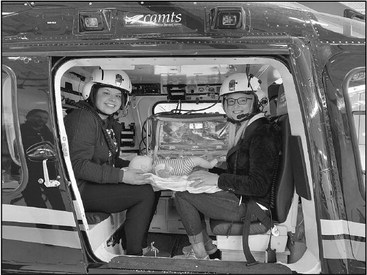CVTC respiratory therapy grads are flying high in new career


A little more than two years after their 2017 graduation from the Respiratory Therapist program at Chippewa Valley Technical College, Megan Wermske and Samantha Gruen help care for some of the most vulnerable patients imaginable. They do it not just in a hospital setting, but on board an aircraft or in an ambulance while the patient is being rushed to the hospital for urgently needed care.
Wermske and Gruen are registered respiratory therapists with training as flight therapists at the University of Minnesota Masonic Children’s Hospital.
“We still work at the university hospital, but part of the opportunities we have at the university is that we can be part of a transport team,” Wermske said.
“We work in all units of the hospital, and have joined the transport team,” Gruen said. “When a transport is called for, we can either transport patients from our facility to outside hospitals, or go and stabilize patients from outside hospitals and bring them to our facility for care.” “The majority of our calls are NICU (Neonatal Intensive Care Unit) patients,” Wermske said. Most often that means premature babies, including “micropreemies” born after just 22 weeks gestation.
For Wermske and Gruen, the training to provide therapy to neonatal patients came from their CVTC associate degrees.
“Every respiratory therapy graduate that leaves our college has neonatal training,” said Theresa Meinen, director of clinical education for the CVTC Respiratory Therapy program. “It really gives them a leg up in job searches. Our graduates typically have multiple job offers.”
Becoming flight therapists was another matter.
“A flight therapist typically has to work a while in the field, and then there is some significant training that they do to become flight therapists,” Meinen said.
Wermske said they needed two years of experience as intensive care unit therapists and completion of simulation exercises to qualify for a flight team.
“We work regular shifts at the hospital, but if an air transport team needs to be gathered one of us may be put on the team,” Wermske said. “If it’s a helicopter transport, we leave from the helipad at the hospital. If it’s a fixed-wing transport craft, an ambulance picks us up and takes us to the airport in Blaine (Minn.).
A flight crew typically consists of the pilot, a respiratory therapist, a registered nurse and a nurse practitioner. “You never know what you’re walking into on a transport.” Wermske said. “It can be more challenging than regular RT work. Everyone’s concern is heightened. But it is so rewarding to see them get better and go home to their parents.”
Wermske and Gruen say their CVTC education prepared them for their work at the University of Minnesota Masonic Children’s Hospital and the extra responsibility of being flight therapists.
“Everything went really well at CVTC. The teachers really worked hard to get to know you and made everything personal,” Wermske said.
“I thoroughly enjoyed my time in the RT program,” said Gruen. “Don (Raymond) and Theresa, my instructors prepared me for my career. It’s a great program and I am proud to have graduated from CVTC.”
“Megan and Samantha were exceptional students who were a delight to have in class,” Meinen said. “They were compassionate, cooperative, diligent workers who worked well with a team.”
With over 155 programs offered both online and oncampus, Chippewa Valley Technical College delivers superior, progressive technical education which improves the lives of students, meets the workforce needs of the region, and strengthens the community. CVTC programs are designed with input of business and industry to prepare graduates for today’s jobs, with 95 percent employed within six months of graduation.
CONTRIBUTED PHOTO
Wermske noted that sometimes a team is sent to a hospital before a baby is born, in anticipation of a premature birth and a high level of care needed.
“Then we’re waiting around for the birth and rapid transport,” Wermske said. “A flight can be less than four hours, or it can be an entire shift or more.” Flights can go as far out as the Dakotas, sometimes farther.
Such calls are literally life-and-death situations in which a very young life hangs in the balance. Only highly competent, level-headed people who can work calmly under pressure need apply.
CVTC Respiratory Therapy program alumni Samantha Gruen, left, and Megan Wermske sit inside a helicopter ambulance holding a medical simulation mannequin when they trained to become flight therapists with the University of Minnesota Masonic Children’s Hospital. They are trained to help premature babies during emergency medical transports.

